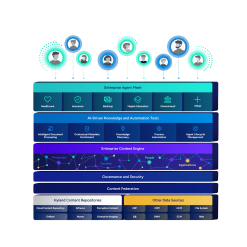5 reasons to embrace enterprise search in your organization
Hyland’s Enterprise Search offering makes locating information simple, straightforward and fast — supporting a variety of use cases.

Harness the power of a unified content, process and application intelligence platform to unlock the value of enterprise content.
Learn more
Automate your document-centric processes with AI-powered document capture, separation, classification, extraction and enrichment.
Learn about Hyland IDPIt's your unique digital evolution … but you don't have to face it alone. We understand the landscape of your industry and the unique needs of the people you serve.
 Overview of industries
Overview of industries
Countless teams and departments have transformed the way they work in accounting, HR, legal and more with Hyland solutions.
 Overview of departments
Overview of departments
We are committed to helping you maximize your technology investment so you can best serve your customers.
 Overview of services
Overview of services

Learn proven strategies, connect with experts, innovate boldly
Register for CommunityLIVE 2026 today
Our exclusive partner programs combine our strengths with yours to create better experiences through content services.
Overview of partners
Join The Shift newsletter for the latest strategies and expert tips from industry leaders. Discover actionable steps to stay innovative.
Register now
Hyland connects your content and systems so you can forge stronger connections with the people who matter most.
Learn about HylandWith our modern, open and cloud-native platforms, you can build strong connections and keep evolving.
 Dig deeper
Dig deeper
As the type and volume of information organizations create continues to increase, every organization faces the same daunting challenge: Answers are impossible to find.
How can your users make decisions, analyze trends and tackle important questions when the answers are hidden in documents, files and other forms of information?
The best search applications are quick and simple to use — like Google or your favorite eCommerce site.
Businesses often fail to appreciate how difficult it is to deliver a great search experience. But when a search isn’t fast and accurate, or when it doesn’t deliver expected results, users can quickly become frustrated.
Although some organizations understand the benefits of enterprise search tools, most workers are still unable to find critical information they need.
Poor search tools hold them back, and many organizations fail to realize how much lost institutional knowledge and productivity can cost.
When employees can’t find the information they need to do their jobs, it affects the efficiency of the entire organization.
The need for better search tools may seem obvious, yet many businesses have not yet adopted enterprise search technology.
Organizations that manage their documents through file shares and collaborate primarily through email most likely have no search capabilities at all.
Enterprise Search addresses the productivity challenge with a single application that provides universal access to all enterprise content regardless of where it’s stored.
> Learn more | How federated search consolidates information from various data sources
Every company faces a common challenge: Well- intentioned employees make simple mistakes and expose confidential information, such as employee information, trade secrets, health records, customer data, classified information and more.
When a company fails to detect inadvertent exposure first, the risk of damage and liability rises. Inadvertent exposure often innocently occurs when:
Regardless of how, when, why and where the inadvertent exposure takes place, the risks of fines or worse are always present.
Enterprise Search equips organizations to implement a confidential information discovery solution — proactively monitoring for and removing confidential information from unauthorized locations across your organization.
Organizations with thousands of knowledge workers understand that their employees need instant access to up-to-date information to make properly informed decisions.
When workers can’t find the right information quickly — especially when managing key projects or investigations — it often results in time wasted, lost business opportunities and improper analysis.
Enterprise Search makes it easy for knowledge workers to locate key information, find corporate insights and identify experts when working on projects and making decisions.
Related articles
With ever-increasing repositories of content and other data, it becomes more and more challenging to connect knowledge workers to corporate-held insight and subject-matter experts. It also increases costs when the connection isn’t made.
Today, many organizations face challenges maintaining and upgrading disparate legacy systems.
Constant technological change often weakens the business value of legacy systems, which have been developed over the years through huge investments. CIOs struggle with the problem of modernizing these systems while keeping their functionality intact.
How can IT leadership know for certain what content needs to be migrated, what needs to be stored and what can go? Unfortunately, it’s an expensive conundrum.
Enterprise Search provides users with access to required content in legacy systems without the need to maintain legacy system licenses.
As the amount of electronically stored information continues to grow with the enterprise, keyword search has gained importance as a way to uncover relevant information – whether to fulfill record requests or when performing an eDiscovery search to find information relevant to litigation or government inquiries.
In legal markets like eDiscovery, it’s extremely critical to catch every document that contains a particular term.
A legal team’s worst nightmare is walking into a proceeding where the other side has documents they didn’t know existed.
Yet cases like this occur every year, at enormous cost.
It’s unacceptable to report that one or more critical documents were missed because an organization’s search engine truncated or ignored some terms or documents.
That excuse may have worked decades ago, but it is no longer a valid argument in today’s demanding enterprise search environments.
Enterprise Search complements eDiscovery search to help organizations find all information relevant to litigation or government inquiries.